Physiography and Geomorphology
Morphology and Process
Historically, some people have described landforms primarily on morphology. While others, such as geologists have tended to emphasise parent material with a greater emphasis placed on process.
Hills first published his book on landforms of Victoria in 1940 (Hills, E. Sherbon, New Edition, 1975). He discussed the interaction between landform and other elements of the environment, which provide the definitions of physiography and geomorphology with reference to the influence of the biosphere (flora and fauna) and atmosphere (climate). Hills suggested in his introduction, that geomorphology tends to be more related to geology. In addition, physiography also relates to the biosphere which is more affected by change, particularly by mankind.
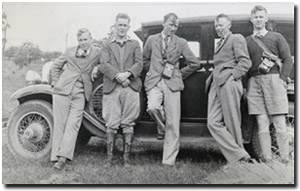 E.S Hills is pictured second from right in this photo taken on an excursion to Kinglake in 1939. Pictured (left to right): K.D Nicolls, R.B Withers, G.W Leeper, E.S Hills, A Blackburn. |
Following the work of Hills, Jenkin (Douglas and Ferguson, 1976) reviewed the broader land types that were developed by Hills. This basic approach was simplified by Rowan in chapter 3 of the Atlas of Victoria (Duncan, 1982). Jenkin and Rowan (1987) further developed the geomorphological hierarchy of Victoria by defining nine geomorphic divisions that were divided into twenty-four geomorphic regions. These are reproduced in detail in Cochrane et al (1991).
These geomorphic divisions and regions were used by Rowan (1990) as a framework for the Statewide Land Systems of Victoria report. He increased the number of geomorphic regions to twenty-nine. Included are published maps at a scale of 1:500,000 and unpublished maps at 1:250,000.
This broadscale map of the Physiographic Divisions of Victoria was developed by Hills, based on earlier work than the most recent published date implies. This was reproduced as an overview diagram at an approximate scale of 1: 7million, where the term "physiography" was the preferred usage, which has subsequently been replaced by "geomorphology". | 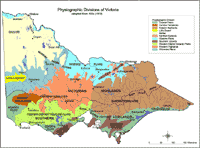 Physiographic Divisions of Victoria (adapted from Hills 1975). |
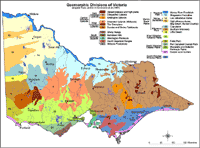 Geomorphic Divisions of Victoria - adapted from Jenkin (in Cochrane et al 1991). | Jenkin reviewed the work of Hills as well as his own research to produce a new scheme of the geomorphic divisions of Victoria. The new scheme is shown in Cochrane et al, 1991, pp 65 at a scale of approximately 1:4 million. |
This map is based on the work of Jenkin, in collaboration with others and is the current standard geomorphic framework for the Statewide Land Systems of Victoria (Rowan 1990). | 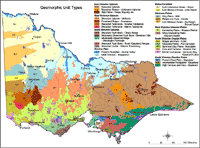 Geomorphic Unit Types |
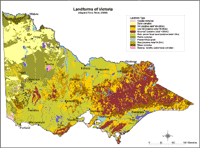 Landforms of Victoria (adapted from Rees 2000). | In the review of the Statewide Land Systems (Rees, 2000) the relative elevation classes (described earlier) have been used to define landform as part of the description for each land system. |


